When given the chance to analyze one design, I immediately thought of Apple's products. Having become a huge fan of Apple 3 years ago upon switching to my first Apple MacBook, I was never able to go back to using anything "PC". The Magic Trackpad is a wireless trackpad that brings the ease of Apple laptop trackpads to all other computers. By looking at the safety, comfort, ease of use, performance (productivity), and aesthetics of the Magic Trackpad, I hope to understand this single design.

The Magic Trackpad is made of aluminum with the same glass surface of MacbookPro trackpads. It differs, however, by having almost 80% more area, which results in it being much larger than a laptop trackpad. In looking at the safety of the object, the Magic Trackpad is very solid and durable, with many rounded edges. The rounded edges prevent any possible puncturing of limbs and other things. At the same time, since it is wireless, there is no danger in tripping over loose wires. Through it's simplistic, minimalistic design, the Magic Trackpad is able to safely perform exactly what it was designed to do.
Comfort wise, the Magic Trackpad is very comfortable to use for extended periods of time. Because of its large size, it enables one to control the computer over a larger area. The solid aluminum is covered by a smooth glass surface, which allows ones fingers to easily glide over the trackpad. The Magic Trackpad is also built at a slight angle, creating a comfortable incline for one to rest their hands.
Along with the safety and comfort presented by the Magic Trackpad, it is also very easy to use. At the most basic level, it is the same as any other trackpad, so one doesn't have to learn any new skills. The connection is also very simple to set up through your computer's bluetooth settings. The only downfall to this is that because the software the Magic Trackpad relies on is fairly new, older Macs need to upgrade to the newest operating system, OSX Snow Leopard in order to use the trackpad. The upgrade, however, is also laughably simple. Personally, I had to upgrade my operating system in order to use the trackpad and I found myself falling in love with Apple's intuitiveness once again. All I had to do was insert the disc with the operating system on it and I was asked if I wanted to upgrade. After that, I didn't need to do any work. Once the new operating system was installed, I turned on the Magic Trackpad and my MacBook easily found the trackpad through bluetooth and installed it. Now, every time I turn on my laptop, my trackpad connects automatically.
Not only is the Magic Trackpad easy to use, but it also performs well and helps increase productivity. The Magic Trackpad is programmed to respond to many different "gestures" that make doing things like zooming in/out, rotating images, and moving between programs a simple "gesture" away. For example, if I wanted to zoom in or out of something, all I would have to do is use two fingers and move them closer together (to zoom out) or move them further apart (to zoom in). By giving one the ability to have shortcuts at their fingertips, the Magic Trackpad is able to help increase productivity because it gives one power that wouldn't be possible with a normal computer mouse or trackpad.
Aesthetically speaking, the Magic Trackpad is reflective of Apple's attention to detail and beauty. The Magic Trackpad has sleek, simple lines and a soft, silver color that allows it to perform it's job and look pretty at the same time. It doesn't have any unnecessary additions in protruding buttons or cords. On the other hand, the necessary additions on the trackpad, like the on/off button and the battery compartment are arranged in a smart, clean manner so that every aspect seems planned and premeditated.

